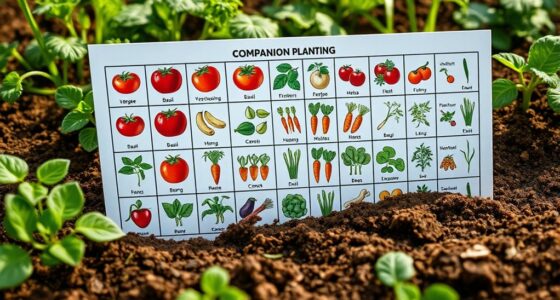Plant parsley alongside carrots, tomatoes, chives, and asparagus to boost pest control and enhance growth. Chives help ward off pests and attract beneficial insects, while parsley’s scent repels aphids and spider mites. Growing dill, lettuce, and spinach nearby can also improve soil health and maximize space. These companions create a healthier, more resilient garden environment, helping your parsley thrive naturally. Keep exploring if you want to discover even more valuable companion plant tips.
Key Takeaways
- Parsley repels pests like aphids and spider mites when planted alongside carrots, tomatoes, and asparagus.
- It attracts beneficial insects such as bees, hoverflies, ladybugs, and parasitic wasps, aiding in pollination and pest control.
- Companion plants like chives and dill enhance parsley’s flavor, support pollinators, and improve overall plant health.
- Growing parsley with carrots and tomatoes promotes healthy development and increases yield through synergistic growth.
- Herbs like chives provide nectar for beneficial insects, creating a resilient, biodiverse garden ecosystem around parsley.
Carrots

Planting carrots alongside parsley can be highly beneficial, as parsley helps repel pests that often target carrots. Carrots are root vegetables that thrive when paired with companion plants that deter common pests like carrot flies and aphids. Parsley, with its strong scent, confuses and repels these insects, reducing damage and increasing your harvest. Additionally, parsley can improve soil health by attracting beneficial insects that prey on pests, creating a balanced garden ecosystem. This pairing also saves space and promotes healthy growth for both plants, as parsley’s leafy growth provides some shade and protection for young carrots. Proper plant placement enhances the effectiveness of companion planting strategies. To further boost your garden’s health, incorporating beneficial insects attracted by parsley can naturally control pest populations and promote a thriving garden environment. Moreover, using integrated pest management techniques can further safeguard your crops without relying solely on chemical controls.
Tomatoes
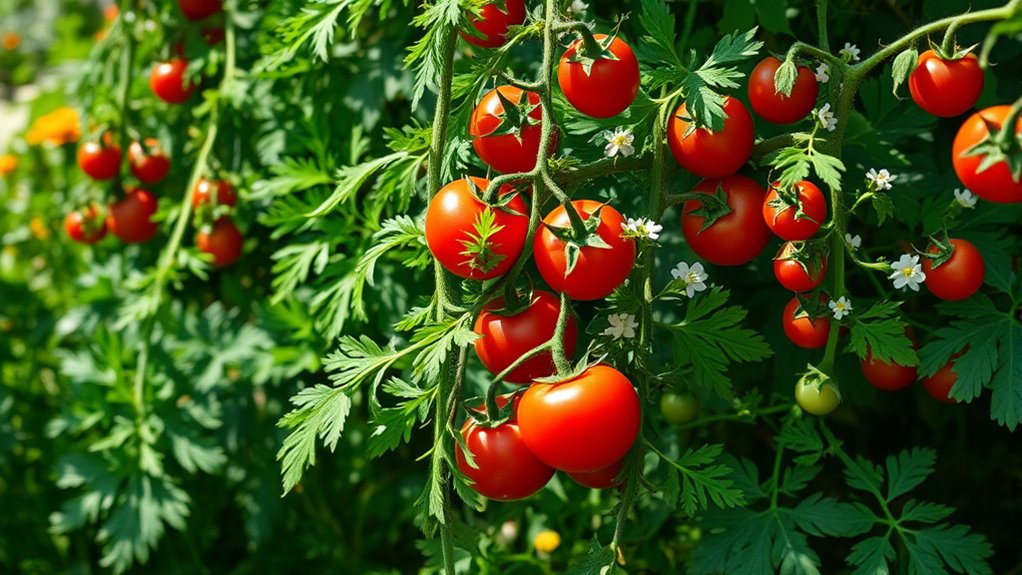
Pairing parsley with tomatoes creates a mutually beneficial relationship that can boost your garden’s productivity. Parsley helps repel pests like aphids and spider mites that often target tomatoes, protecting your crop naturally. Meanwhile, tomatoes provide shade for parsley, helping it stay cool and retain moisture during hot weather. This pairing also encourages healthier growth since parsley’s aromatic leaves can improve soil health by attracting beneficial insects that control pests. You’ll find that parsley’s presence near tomatoes can lead to larger, more robust fruit and a more resilient garden overall. Additionally, incorporating disease prevention techniques can further enhance the success of this pairing. Keep in mind, planting parsley near tomatoes doesn’t interfere with their growth, making this duo an excellent choice for maximizing space and yields in your garden.
Chives
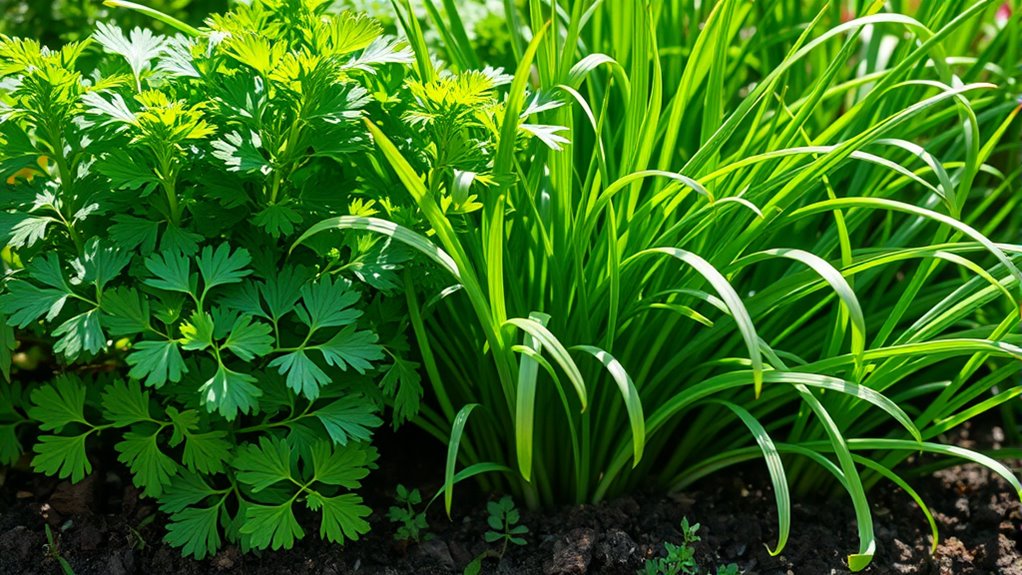
Chives can help protect your parsley by deterring pests and attracting beneficial insects. They also enhance the flavor of your herbs, making your garden more aromatic. Plus, their presence encourages helpful insects to stick around and keep pests in check.
Pest Deterrent Properties
Chives are known for their ability to repel pests that commonly threaten parsley, such as aphids and spider mites. Their strong onion-like aroma acts as a natural deterrent, making it less attractive for these pests to settle nearby. When you plant chives alongside parsley, you’ll notice fewer infestations and healthier plants overall. The scent of chives confuses pests’ sensing abilities, preventing them from locating parsley easily. Additionally, chives can help reduce the spread of certain fungal diseases, indirectly protecting your parsley. Incorporating chives into your herb garden creates a protective barrier, decreasing your need for chemical pesticides. Enhanced natural pest deterrents are increasingly integrated into organic gardening practices to promote sustainable plant health. Moreover, the companion planting method enhances the overall health of your garden ecosystem by encouraging beneficial insects and microorganisms.
Enhances Flavour Profile
Adding chives to your parsley garden can considerably enhance the herb’s flavor, making your dishes more vibrant and aromatic. When grown together, chives release subtle sulfur compounds that complement parsley’s fresh, grassy notes. This combination creates a more complex flavor profile, elevating your culinary creations. The mild onion-like taste of chives blends seamlessly with parsley’s brightness, adding depth without overpowering. Incorporating chives also encourages a balanced herb mixture, resulting in a more nuanced taste experience. Plus, harvesting both herbs together simplifies your cooking process, as you can pick fresh chives and parsley simultaneously. Additionally, herb companion planting in gardening is increasingly used to optimize herb cultivation, ensuring healthier plants and more consistent flavors. Utilizing plant synergy can further improve the growth and flavor development of both herbs. Moreover, engaging in biodiversity-friendly gardening practices can support beneficial insects and improve overall plant health, leading to better herb quality. Incorporating a variety of natural materials like wood and stone in your garden setup can also enhance the growth environment for your herbs. Overall, planting chives alongside parsley enriches the herbs’ flavors, helping you craft more flavorful and aromatic meals with ease.
Attracts Beneficial Insects
Because chives produce clusters of small, nectar-rich flowers, they attract a variety of beneficial insects to your parsley garden. Bees and hoverflies are drawn to the flowers, helping with pollination and controlling pest populations. Ladybugs and parasitic wasps may also visit, targeting common pests like aphids and caterpillars. By planting chives near parsley, you create an ecosystem that encourages these helpful insects to stay and protect your plants naturally. This reduces the need for chemical pest control and promotes a healthier garden environment. Regularly blooming chives act as a continual source of nectar, ensuring beneficial insects remain active and beneficial throughout the growing season. Additionally, natural pest control methods like attracting beneficial insects are essential for sustainable gardening. The presence of diverse plant species such as chives can also enhance biodiversity, creating a more resilient garden ecosystem. Including flowering herbs like chives can also support pollination rates, leading to increased fruit and vegetable yields. Moreover, the strategic placement of chives can help establish a beneficial insect habitat, which sustains these helpful creatures year-round. Creating a diverse planting area also encourages mutualistic relationships between plants and insects, further strengthening your garden’s health. Overall, chives serve as a natural insect attractant that supports your parsley’s health and productivity.
Asparagus
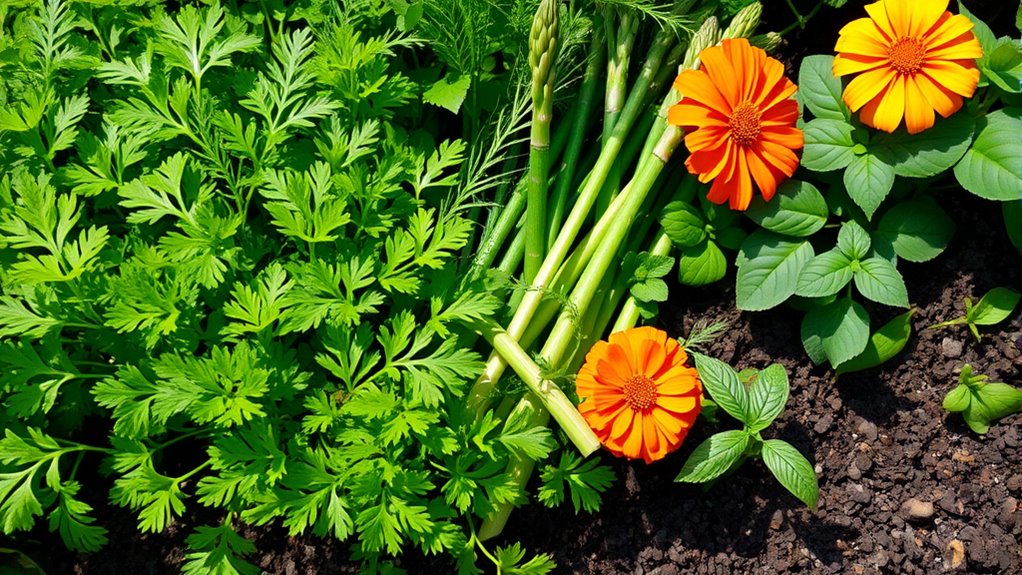
Planting parsley near asparagus can boost your garden’s productivity, as the two work well together. Parsley repels pests that often target asparagus, like aphids and asparagus beetles, helping keep your crop healthy. Additionally, parsley attracts beneficial insects such as predatory wasps and ladybugs, which naturally control pests. The benefits of companion planting can further improve your garden’s health and yields. Asparagus benefits from this symbiotic relationship by remaining healthier and producing more spears. Parsley’s deep roots don’t compete with asparagus, so both plants thrive side by side. You’ll find that parsley’s leafy growth provides some shade, reducing weeds and conserving soil moisture. integrated pest management strategies can further enhance the health of your garden ecosystem.
Dill
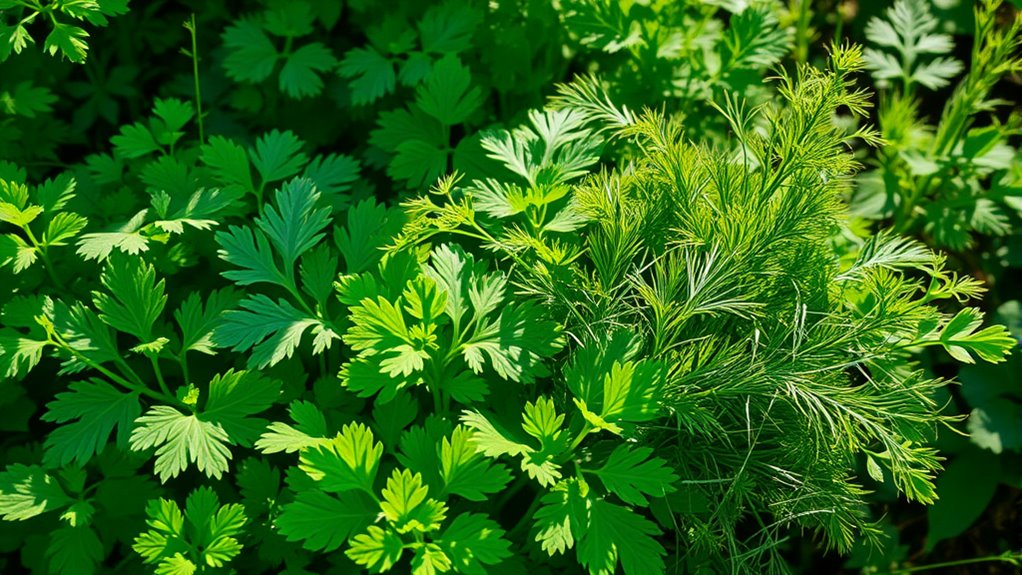
Dill is an excellent companion for parsley, as it attracts beneficial insects that help control common pests. By planting dill nearby, you encourage natural pest control, reducing the need for chemicals. Dill also benefits from parsley’s growth, creating a mutually supportive environment. Keep in mind, though, that dill can sometimes overpower parsley if planted too close, so give them some space. To help you visualize, here’s a quick guide:
| Benefit of Dill | Why It Matters |
|---|---|
| Attracts beneficial insects | Keeps pests at bay |
| Enhances flavor | Complements parsley taste |
| Easy to grow | Low maintenance |
| Repels aphids | Protects nearby plants |
| Improves soil | Adds organic matter |
Together, dill and parsley work harmoniously to create a thriving garden. Incorporating companion planting techniques can further optimize plant health and productivity.
Lettuce
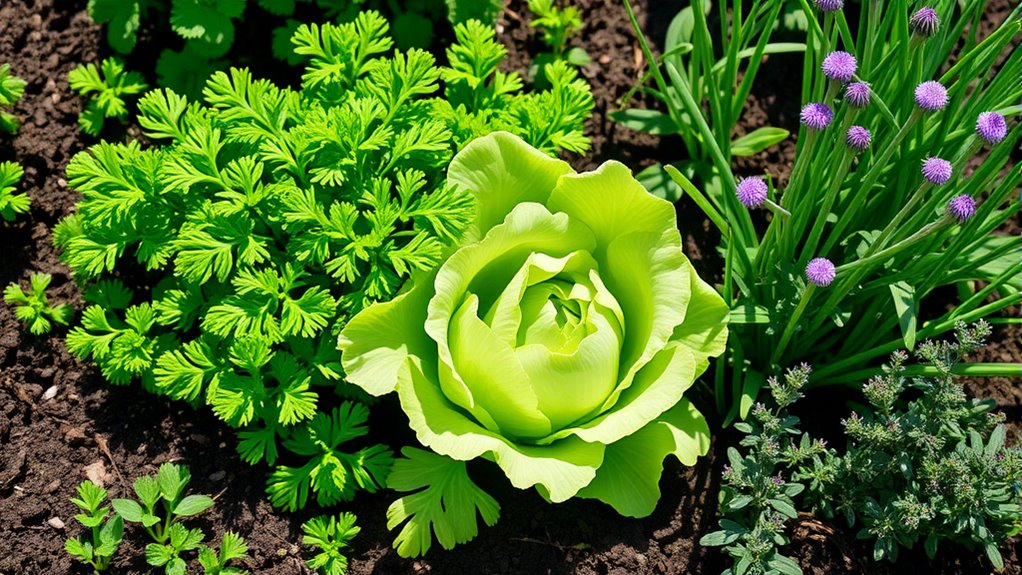
Lettuce makes a great companion for parsley, as planting them together can improve growth and health. Lettuce benefits from the shade that parsley’s taller leaves provide, helping it stay cool and retain moisture. In return, lettuce won’t compete aggressively for nutrients, making them a balanced pairing. Both plants prefer similar soil and watering conditions, so they thrive side by side. Plus, lettuce’s quick growth can help fill gaps in your garden, making efficient use of space. This pairing also encourages pest control; parsley’s aromatic leaves may deter common pests that target lettuce. By planting lettuce near parsley, you create a mutually beneficial environment that promotes healthy, vigorous growth for both. It’s an easy, effective way to optimize your garden’s productivity. Understanding companion planting can help you select the best pairs for a thriving garden ecosystem.
Spinach
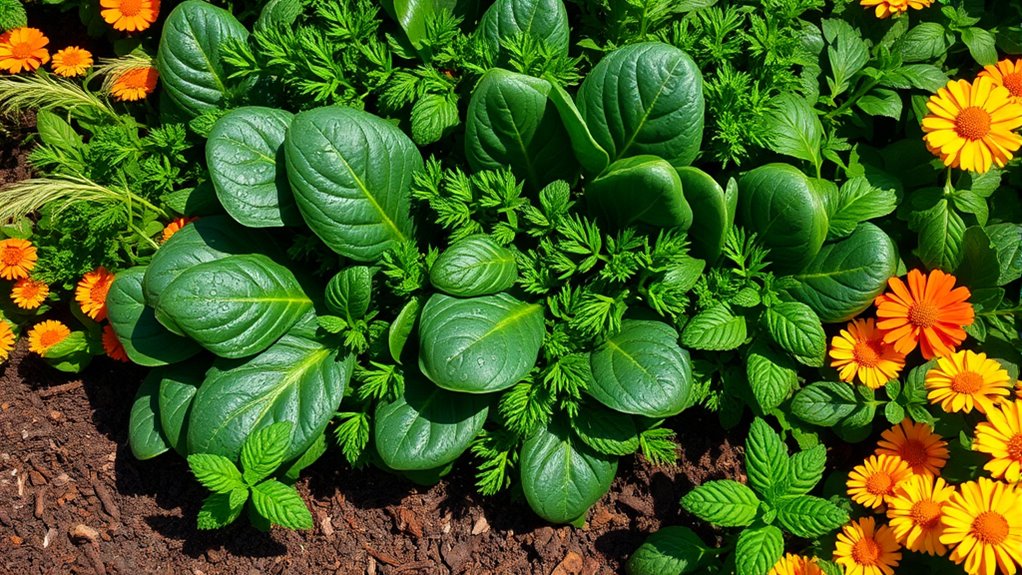
Pairing parsley with spinach creates a harmonious garden duo that boosts growth and health. Spinach benefits from the shade provided by parsley’s taller leaves, which helps prevent bolting and extends its harvest. Both plants thrive in similar soil conditions—rich, well-draining, and moist—making them easy companions. Spinach is also a quick grower, so planting it near parsley ensures you’re maximizing space efficiently. Additionally, spinach’s nitrogen-fixing abilities improve soil fertility for both plants. Keep an eye on watering needs, as spinach prefers consistent moisture. Avoid planting spinach with crops that may compete for nutrients or shade, but parsley’s light touch makes it an ideal partner. Together, they create a vibrant, productive patch that benefits your entire garden. Regularly monitoring your garden’s payment processing systems can help ensure smooth transactions and protect your investment.
Frequently Asked Questions
Can Parsley Be Grown Successfully Indoors With Companion Plants?
Growing parsley indoors with companion plants is definitely doable and can be quite successful. You should choose plants that thrive in similar conditions, like basil, chives, or oregano, which all enjoy similar light and watering needs. Make sure your parsley gets enough sunlight or use grow lights. Keep the humidity balanced, and you’ll create a healthy environment for your parsley and its companions to flourish indoors.
Which Companion Plants Help Deter Pests From Parsley?
You want to know which companion plants help keep pests away from parsley. You should plant basil nearby, as it repels aphids and mosquitoes. Marigolds also work well, deterring nematodes and beetles. Chives and garlic are effective against aphids and other insects. By incorporating these plants into your garden, you create a natural pest barrier that protects your parsley without chemicals, promoting healthier growth.
Are There Any Plants That Improve Parsley’s Growth Naturally?
Did you know that certain plants can boost parsley’s growth naturally? You might consider planting chives nearby, as studies show they can increase parsley’s essential oil production by up to 20%. You’ll notice healthier, more vigorous parsley when you include these companions in your garden. Plants like basil or marigolds also improve soil health and attract beneficial insects, creating an environment that naturally enhances parsley’s growth and flavor.
How Do I Choose the Best Companion Plants for Limited Garden Space?
When choosing companion plants for a limited garden space, focus on plants that grow well together and maximize your area. Opt for compact, fast-growing herbs like basil or chives that don’t overshadow parsley. Mix in low-growing vegetables such as lettuce or radishes to utilize vertical space efficiently. Avoid overcrowding by selecting plants with similar water and sunlight needs, ensuring everything thrives without competing for resources.
Can Herbs Like Basil or Cilantro Serve as Good Companions for Parsley?
Herbs like basil and cilantro can be excellent companions for parsley. They grow well together because they share similar sunlight, water, and soil needs, and they can help repel pests. Planting them nearby encourages healthy growth, and you’ll enjoy the aromatic benefits. Keep in mind, though, to give each herb enough space to thrive, so your garden remains balanced and productive.
Conclusion
So, there you have it—your secret squad of parsley’s best friends. Just imagine the chaos if they all teamed up; a garden party nobody wants to miss. But in reality, it’s not just about boosting your plants’ ego; it’s about working smarter, not harder. So go ahead, plant wisely, and watch your garden thrive. After all, who knew that a little plant gossip could lead to such lush, flavorful success?




